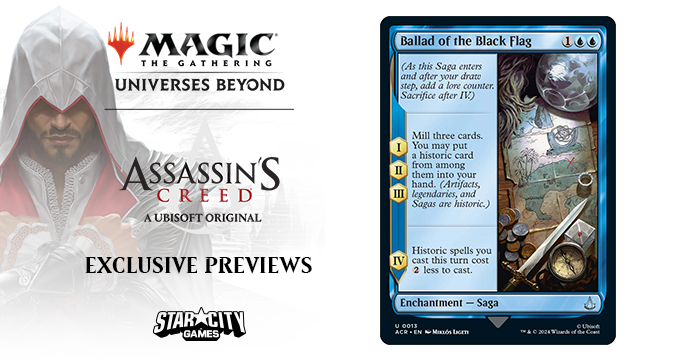The Assassin’s Creed games have been a huge part of my life since they first came out in 2007, almost as long as I have been playing Magic: The Gathering, so I’m thrilled to present three new cards from the Magic: The Gathering – Assassin’s Creed set! The fight between the Assassin Brotherhood and the Templar Order spans millennia in the games, but the lore goes much further back.
Ballad of the Black Flag
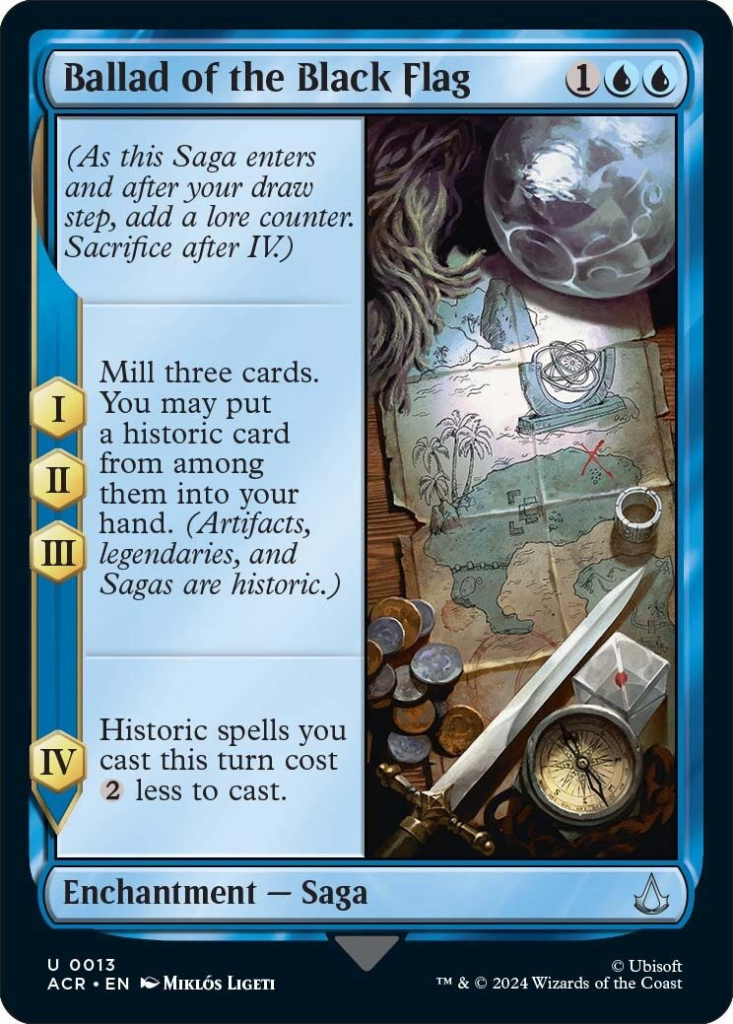
Assassin’s Creed IV: Black Flag has been one of my favorite video gaming experiences for a long time, so I’m excited to explore its Ballad. First up, the flavor of the mechanics is fantastic. Black Flag sets you as a pirate, Edward Kenway, during the Golden Age of Piracy, traveling the seas with your crew. The first three chapters of the Saga let you dig for buried treasure. Then, the final chapter allows you to spend that ill-gotten treasure at a discount.
Looking at the artwork, there are several references to the game packed in a tight space here. If you’ve had a passing interest in the games, or have only played a few of them, you might be familiar with the fact that each game has several storylines going on. In the early games in the series, you play in the modern day as Desmond Miles and learn that there’s a technology to dive into the memories of a person’s ancestors through their DNA. This originally takes place through a machine called The Animus, but starting with Black Flag, there are other ways to interact with those memories. The characters, both present-day and the ancestral memories, also learn of and interact with a precursor race known as The First Civilization, or the Isu (this is important for another card down the line.)
The Isu ruled over the Earth tens of thousands of years ago and had advanced technology, with several artifacts called the Pieces of Eden scattered around the world after their downfall. In the upper right corner of the artwork is an example of a Piece of Eden, one of the Crystal Skulls. The Crystal Skulls had a few different types of effects. One style acted as a communication device, another as a recording and playback device, and the last is what appears in Black Flag, a surveillance device when combined with a vial of blood, which also appears in the art as a glass cube with a drop of blood inside. When a living person’s blood is added to the Crystal Skull, the person can be spied on across vast distances through a station called The Observatory, which is depicted on the drawn map as an Armillary Sphere.
The other Piece of Eden shown in the art is the ring on the right-hand side. This Ring of Eden is slightly odd in the Saga artwork, as it didn’t appear in Black Flag, but instead in the previous entry in the series, Assassin’s Creed III. The ring belonged to the pirate William Kidd, who buried it and gave clues to his most trusted crew members before he died. The main playable character in Assassin’s Creed III, Ratonhnhaké:ton, finds the clues and uncovers the ring, which has the ability to deflect metal projectiles coming towards the wearer.
Fall of the First Civilization
As I mentioned before, The First Civilization, or the Isu, were a highly-advanced species that lived on earth. In-game, they actually created humanity along with the Pieces of Eden.
Minerva: No. Not gods. We simply came… before.
– Assassin’s Creed II
The Pieces of Eden were created as ways to control the humans that the Isu created, but eventually hybrids of the two were born that could resist the effects of the Pieces of Eden and started a rebellion against the Isu. After a decade of war, the Isu discovered that there would be a worldwide extinction event due to a coronal mass ejection. The Capitoline Triad of Minerva, Juno, and Jupiter attempted to come up with several solutions to protect themselves and the Earth, but none of the methods worked.
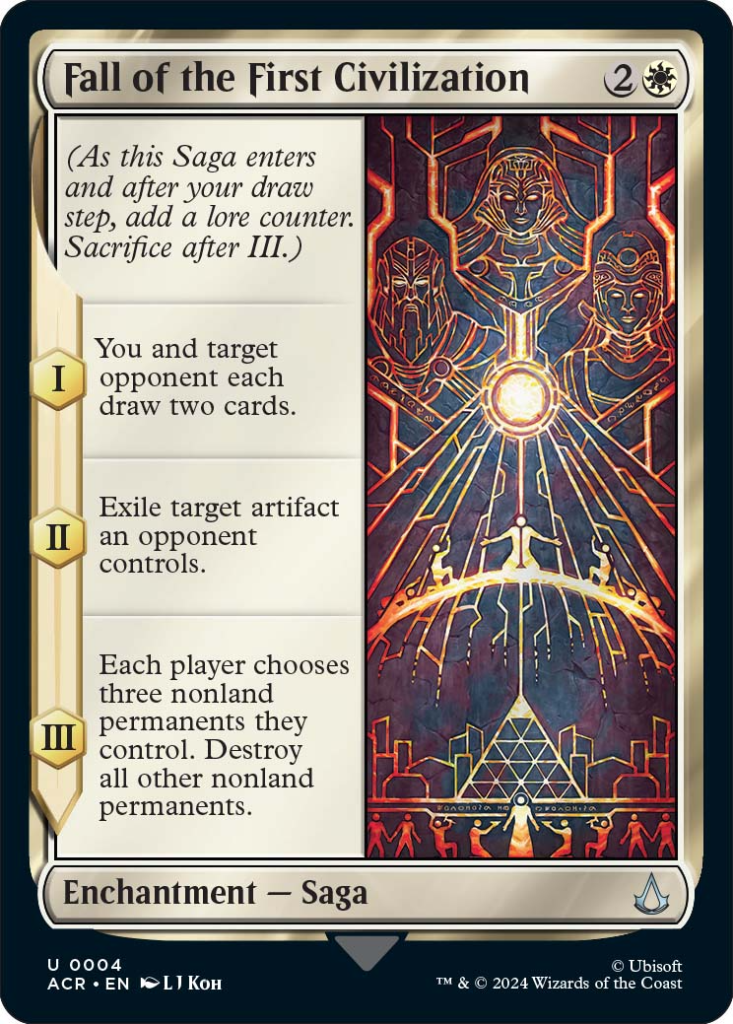
The first chapter of the Saga shows the desperate search for knowledge, even at the cost of sharing the wealth with an opponent. The second chapter represents when Minerva and Jupiter found out that Juno had manipulated some of their work to send messages to the present day, so they killed Juno and destroyed the device used to send the messages. The third chapter is a great representation of The First Catastrophe, where almost everything is destroyed but leaves each player the ability to rebuild.
The artwork depicts Juno, Minerva, and Jupiter at the top, and shows the effects of The First Catastrophe on the world, with the people above suffering the consequences, while a smaller group of humans on the bottom survives with an even smaller group of Isu.
As the Assassin’s Creed series is a historical fantasy, the First Catastrophe has a real-world equivalent that it’s based on, the Toba eruption, which occurred about 74,000 years ago. This eruption likely caused a volcanic winter and cooled the Earth for over 1,000 years, which may also have led to the early human population dropping to as low as 3,000-10,000 individuals. The modern-day sections of the first several games also revolved around the real-world doomsday belief that the world would end in December 2012. A Second Great Catastrophe was going to occur on the predicted date in-game, but the characters were able to prevent it.
The Aesir Escape Valhalla
One of the more recent games in the series, Assassin’s Creed Valhalla, takes place in 873CE across Norway and England, where you play as the Viking warrior Eivor. (The player can choose to play Eivor as either male or female, and for my playthrough I chose female, so I will be using she/her pronouns.) During Valhalla, the player learns that the Isu split into several groups, including the Aesir in Scandinavia. (It’s also sort of funny that Magic stopped using the Æ ligature, as the in-game form is “Æsir”.)
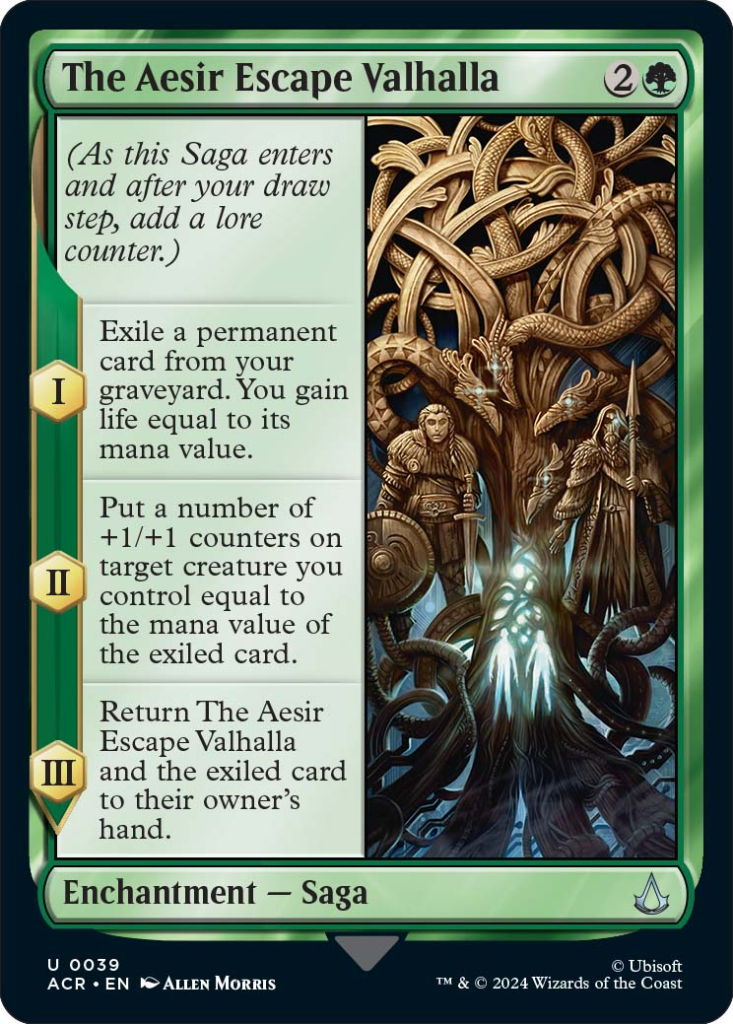
As Valhalla is less than five years old, this section comes with a spoiler tag.
I hope you enjoyed this lore dive into these new cards from Magic: The Gathering – Assassin’s Creed! I can’t wait to get my hands on the cards, and you can order yours here at StarCityGames.com.
***
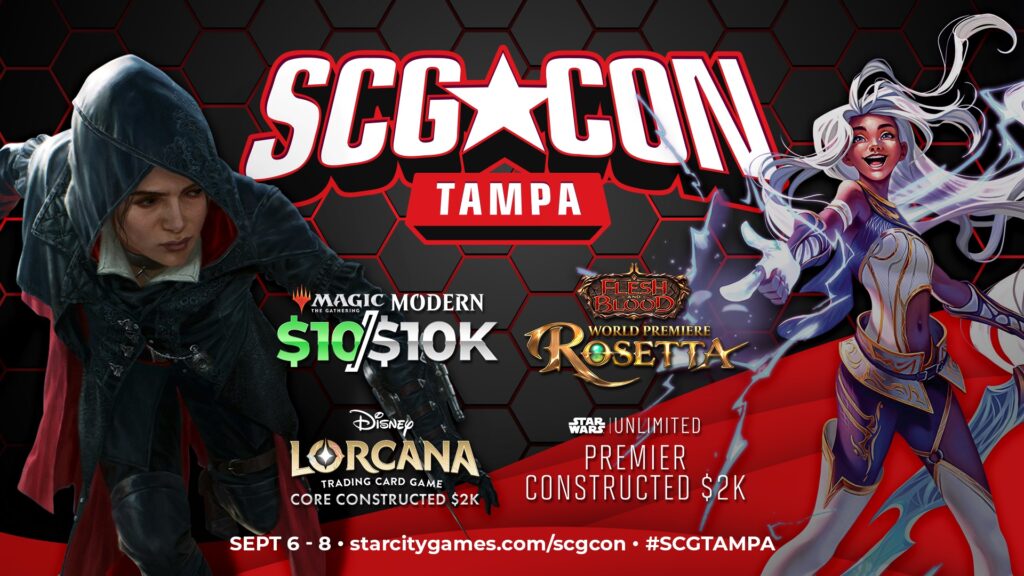
SCG CON is coming to Tampa, FL on September 6-8! The world’s premier trading card game convention features three full days of Magic: The Gathering, Flesh and Blood, Disney Lorcana, and Star Wars Unlimited action:
- Magic: The Gathering Modern $10Ks on Friday and Saturday; cEDH $5K; Super Sunday Regional Championship Qualifiers in Standard, Pioneer, and Modern; and Commander Celebration
- Flesh and Blood Rosetta World Premiere, Calling, and Battle Hardened events
- Disney Lorcana Core Constructed $2K and $1K events
- Star Wars Unlimited Premier Constructed $2K and $1K events
- Side events all weekend long
And so much more!
Plus, meet fan-favorite special guests and artists!
Best of all, SCG CON is free to attend!
Make your plans for SCG CON Tampa!

